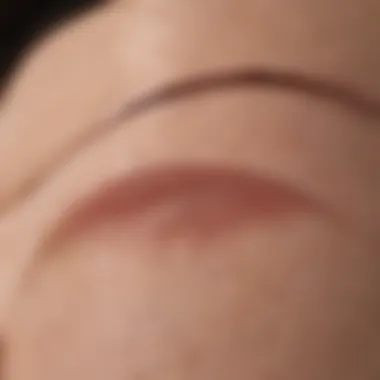Effective Solutions for Ingrown Hairs on Bikini Line


Intro
Ingrown hairs present a significant concern for many, especially in delicate areas like the bikini line. Frequently caused by improper hair removal techniques, these discomforts can lead to irritation, inflammation, and sometimes infection. Understanding how to tackle this issue effectively is vital for maintaining skin health and comfort.
This article delves into practical solutions, ranging from self-care practices to professional interventions. A thorough understanding of the root causes can enhance effectiveness in both treating and preventing further occurrences.
By being informed on various methods and products, individuals can select strategies that are best suited for their unique skin types and needs.
Trending Topics
Current Fashion Trends
In recent years, fashion has shifted towards embracing natural beauty. Women are more mindful about their skin health and grooming practices. The bikini line is a key area of focus, given its visibility during swimsuits and summer attire.
The desire for smooth skin has prompted a rise in the popularity of products and treatments specifically targeting ingrown hairs. With many options available, individuals often seek out the most effective solutions to integrate into their beauty routines.
Beauty Innovations
Innovations in skincare and hair removal have revolutionized the approach to preventing ingrown hairs. Many brands now offer specialized exfoliants, moisturizers, and hair removal tools aimed at minimizing this common issue. Advances in laser hair removal also provide long-term solutions, reducing the frequency of ingrown hairs dramatically. These innovations are not just about comfort; they increasingly align with sustainable and eco-friendly practices, reflecting a broader trend in the beauty industry.
Step-by-Step Guides
Hair Removal Techniques
Using the right hair removal method can greatly impact the chance of developing ingrown hairs. Here are effective approaches:
- Shaving: Ensure the skin is moist, use a clean razor, and shave in the direction of hair growth.
- Waxing: While it can be painful, waxing pulls hair from the roots, resulting in longer-lasting smoothness. Ensure proper aftercare.
- Laser Hair Removal: This is a long-term solution, targeting hair follicles to reduce future growth.
Skincare Routine
Maintaining a good skincare routine is essential to prevent ingrown hairs. Consider the following steps:
- Exfoliate Regularly: Use products with salicylic acid or gentle scrubs to keep skin smooth and remove dead skin cells.
- Moisturize: Keeping the skin hydrated helps maintain its elasticity and prevents hair from becoming trapped.
- Avoid Tight Clothing: Restricting clothing can irritate the skin and exacerbate the problem.
"Incorporating a routine that focuses on preparation before hair removal and care afterward can significantly reduce the occurrence of ingrown hairs."
Product Reviews
In-Depth Analysis of Popular Items
Brands like Tend Skin and Bump Patrol offer specific formulations targeting ingrown hairs. They contain ingredients designed to calm irritation and prevent future occurrences. Consistent use may bring lasting relief.
Comparative Reviews
Several lasers, such as the Tria SmoothBeauty Laser, are praised for their effectiveness in reducing ingrown hairs over time. Comparing products helps consumers make informed decisions tailored to their specific needs.
By understanding current trends and applying practical strategies, individuals can navigate the complexities of ingrown hair management effectively.
Understanding Ingrown Hairs
Ingrown hairs present a common yet often frustrating concern for many, particularly in sensitive areas like the bikini line. Comprehending ingrown hairs can facilitate effective prevention and treatment methods. Understanding not only the technical aspects but also the cultural perceptions related to body hair removal can aid in developing individualized care strategies. This section will clarify definitions, causes, symptoms, and the demographics most affected by ingrown hairs. Addressing this subject matter will help readers reduce their occurrences and maintain smoother skin.
Definition and Causes
Ingrown hairs occur when hair grows back into the skin instead of outward. This phenomenon may happen due to several reasons. The most prevalent cause is hair removal, through methods like shaving, waxing, or plucking, which can result in broken hairs that can curl back into the skin. Individuals with curly or coarse hair are especially at risk, as the shape of their hair makes it more likely to penetrate the skin.
Other underlying factors also contribute to the occurrence of ingrown hairs. For example, the use of tight clothing can increase friction and pressure on the skin, further exacerbating the problem. Additionally, skin conditions such as acne or keratosis pilaris can block hair follicles, creating a conducive environment for ingrown hair development.
Symptoms and Appearance
The symptoms of ingrown hairs can vary, but common signs include:


- Red bumps resembling pimples on the skin
- Pain or tenderness around the ingrown hair
- Itching or irritation in the affected area
When observing an ingrown hair, one might notice the hair trapped below the surface of the skin, often leading to noticeable inflammation. In some cases, these bumps may become infected, resulting in pus-filled lesions. The visible symptoms can serve not only a diagnostic purpose but also remind individuals to address the underlying issue to promote skin health.
Who is Most Affected
While anyone can experience ingrown hairs, certain groups are more significantly affected. People with curly or coarse hair, regardless of gender, face a higher likelihood of ingrown hairs. Ethnic backgrounds also play a role; for instance, African individuals may have a genetic predisposition to this skin condition when compared to others.
Moreover, individuals who frequently remove hair from their bodies, particularly in sensitive regions such as the bikini line, are predisposed to ingrown hairs. Understanding demographics that are more vulnerable can help tailor prevention and treatment strategies effectively.
"Understanding the underlying factors of ingrown hairs can inspire more effective solutions for individuals experiencing this issue."
Recognizing these elements is essential for developing tailored management strategies, ensuring smoother skin and improved overall comfort.
Preventing Ingrown Hairs
Preventing ingrown hairs is crucial in mitigating discomfort and skin irritation, especially in delicate areas like the bikini line. Understanding this section helps individuals take proactive measures, promoting healthier skin and avoiding the common pitfalls that lead to ingrown hairs. Prevention not only enhances overall appearance but also boosts confidence when it comes to skin exposed in swimwear or intimate settings. It's essential to establish a routine that includes proper hair removal techniques, consistent moisturizing, and regular exfoliating.
Pre-Hair Removal Tips
Before any hair removal, preparation is key. Effective pre-hair removal practices set the stage for minimizing potential ingrown hairs. Here are a few essential tips:
- Hydrate the Skin: A well-hydrated skin is less prone to irritation. Drink adequate water and apply moisturizing lotion before hair removal to protect the skin barrier.
- Warm Up the Area: Taking a warm shower or applying a warm cloth softens hair and opens up the pores. This process makes hair removal smoother and reduces the risk of hair curling back into the skin.
- Clean the Skin: Washing the area with a gentle cleanser removes dirt and oil, ensuring nothing obstructs the hair removal process.
- Use a Suitable Exfoliant: Lightly exfoliating the skin a day prior helps clear away dead skin cells, giving hair less chance to get trapped under the surface post-removal.
Choosing the Right Hair Removal Method
The method of hair removal plays a significant role in the likelihood of developing ingrown hairs. Each method has its own merits and drawbacks, varying in effectiveness based on individual skin types and hair textures. Understanding these differences is vital in choosing the right approach.
Shaving
Shaving is popular due to its convenience and speed. It can be an effective method if done correctly. The key characteristic of shaving lies in its immediacy. It allows for a quick touch-up that many find appealing. However, using a dull blade or improper technique may lead to irritation, making hairs grow in various directions, which can amplify the risk of ingrown hairs. Investing in high-quality razors and shaving cream tailored for sensitive skin can alleviate some concerns associated with this method.
Waxing
Waxing provides a longer-lasting hair removal solution, pulling hair directly from the follicle. This can slow down hair regrowth, reducing overall frequency of hair removal. People often choose waxing for its efficacy in yielding smoother results. Nevertheless, it can be painful, especially in sensitive areas like the bikini line, and may lead to redness or bumps, posing risks for ingrown hairs if proper aftercare is not followed.
Laser Hair Removal
Laser hair removal presents a more permanent solution, targeting hair follicles with laser light. The effectiveness of this method significantly reduces the chances of future ingrown hairs. Its key characteristic is providing a long-term reduction in hair growth. However, the process can be costly and is often encouraged in a series of treatments. It may not be suitable for all skin types or hair colors, so individuals should consult professionals before proceeding.
Depilatory Creams
Depilatory creams dissolve hair at the skin’s surface, offering a painless alternative to traditional shaving. These creams can be beneficial because they do not cut hair, reducing the likelihood of it growing back into the skin, an advantage for preventing ingrown hairs. However, strong chemicals can provoke allergic reactions or irritate sensitive skin. It is essential to perform a patch test before full application to identify any adverse reactions.
Proper Technique for Hair Removal
No matter which hair removal method one opts for, employing the proper technique is critical. For shaving, using a quality razor, shaving in the direction of hair growth, and replacing blades regularly can significantly lower the risk of ingrown hairs. For waxing, ensuring the technician is experienced minimizes trauma to the skin. Those opting for laser treatments should follow a pre-treatment guideline provided by the practitioner. Overall, applying suitable aftercare, including moisturizing and not wearing tight clothing post hair removal, helps maintain skin health and reduces the incidence of ingrown hairs.
Effective Home Remedies
Home remedies can be very effective when it comes to dealing with ingrown hairs on the bikini line. They provide a blend of relief, prevention, and overall skin health. This section will explore various methods that can easily be incorporated into a regular skincare routine, emphasizing their advantages. Proper use of these remedies may alleviate discomfort and promote skin healing after hair removal.
Exfoliation Techniques
Exfoliation plays a crucial role in preventing and treating ingrown hairs. By removing dead skin cells, it helps maintain clear hair follicles. This can significantly reduce the likelihood of hairs curling back into the skin.
Physical Exfoliants
Physical exfoliants refer to products that manually scrub the skin's surface. Typical examples include scrubs with sugar, salt, or microbeads. The key characteristic of physical exfoliants is their immediate action. They physically remove dead cells, allowing hair to grow outward properly. Selecting grainy textures can be particularly beneficial; however, it is crucial to use them gently. Over-exfoliating can irritate sensitive skin and worsen the problem.
Advantages of physical exfoliants include their availability and straightforward application. They offer instant results, which can be satisfying. On the downside, they might cause micro-tears in the skin if used too vigorously, leading to irritation or inflammation.
Chemical Exfoliants


Chemical exfoliants differ from physical options by utilizing acids to dissolve dead skin cells. Common ingredients include alpha hydroxy acids (AHAs) and beta hydroxy acids (BHAs). The primary benefit here is their ability to penetrate deeper into the skin. This can help prevent ingrown hairs at their source by keeping follicles clear.
A notable feature of chemical exfoliants is their ease of use. They often come in serums or toners, requiring less effort compared to scrubs. However, one must be cautious as these products can increase skin sensitivity, particularly in sunlight. Daily use might not suit everyone, so it’s smart to start slow.
Moisturizing Options
Moisturizers are essential for maintaining skin hydration. A well-hydrated skin barrier can fend off irritation and support overall skin health. This section discusses two significant moisturizing options: natural oils and lotions.
Natural Oils
Natural oils, such as coconut oil or jojoba oil, have become popular for their moisturizing and soothing properties. Their key characteristic is their ability to penetrate the skin deeply. This supports both hydration and healing, reducing inflammation associated with ingrown hairs.
The unique feature of natural oils lies in their natural composition; they often include vitamins and fatty acids that nourish the skin. On one hand, they are organic and free from harsh chemicals, making them suitable for sensitive areas. However, some people might find oils can clog pores if overused. Balance is essential for best results.
Lotions and Creams
Lotions and creams provide another effective moisturizing option. They typically combine water and oil, creating a blend that hydrates without feeling too greasy. The key characteristic of lotions is their lightweight nature, which can feel refreshing on the skin.
Formulations containing ingredients like aloe vera or chamomile can be particularly beneficial. These ingredients soothe the skin while providing hydration. However, one potential drawback is that not all lotions are created equal. Some contain irritants. Always check labels to ensure they are suitable for sensitive skin.
Warm Compress Applications
Applying a warm compress can effectively relieve existing ingrown hairs. The warmth opens up the pores and aids in reducing inflammation. It provides temporary relief from discomfort and may help draw the hair out.
To implement this method, dampen a clean cloth in warm water, ensuring it is not too hot. Apply it to the affected area for around 10 to 15 minutes. Doing this a few times throughout the week can enhance the skin's ability to heal.
Using effective home remedies can lead to both immediate relief and long-term solutions for dealing with ingrown hairs. They cater to individual needs while addressing skin health comprehensively.
Over-the-Counter Treatments
Over-the-counter treatments are significant in managing ingrown hairs on the bikini line. They offer quick relief and make it easier for individuals to address discomfort at home. Many products can reduce inflammation, promote healing, and prevent future occurrences of ingrown hairs. By choosing the right over-the-counter options, one can effectively manage the symptoms and enhance skin health.
Anti-Inflammatory Creams
Anti-inflammatory creams can be an essential first step in treating ingrown hairs. These products help in reducing redness and swelling around the ingrown hair site. Common ingredients in these creams include aloe vera and camomile, known for their soothing properties. Applying such creams not only brings immediate relief but also supports skin recovery. Often, these creams can be found in pharmacy or beauty stores without the need for a prescription.
- Key Benefits:
- Reduces irritation and redness.
- Helps in faster healing process.
- Can be used daily as needed.
Salicylic Acid and Its Benefits
Salicylic acid is another popular ingredient found in many over-the-counter products formulated for skin issues, including ingrown hairs. It works as a keratolytic agent, meaning it helps to exfoliate the skin. By gently removing dead skin cells, salicylic acid allows hair to break through the skin's surface more easily. This reduces the chance of hair curling back into the skin and forming more ingrown hairs.
- Benefits Include:
- Helps prevent new ingrown hairs from developing.
- Assists in minimizing existing bumps and irritation.
- Can be used in cleansers or spot treatments.
Hydrocortisone Creams
Hydrocortisone creams are another option for treating ingrown hairs. This type of cream is a mild corticosteroid that helps in reducing inflamation and alleviating itching. Use hydrocortisone creams sparingly, as prolonged use may thin the skin. Generally, a thin application on affected areas after hair removal can prevent flare-ups of ingrown hairs effectively. For best results, it is wise to follow the recommendations provided by the product label or advice from a dermatologist.
- Considerations:
- Do not use for prolonged periods.
- Apply in thin layers to avoid skin thinning.
- Consult a healthcare professional if symptoms persist or worsen.
Overall, incorporating these over-the-counter treatments can significantly improve the management of ingrown hairs. They provide both immediate relief and support long-term skin health.
Professional Treatments
When dealing with ingrown hairs, professional treatments can provide a significant advantage. They often offer specialized solutions and expertise that go beyond basic at-home remedies. Understanding these options can help individuals make informed choices about their skin care, particularly in sensitive areas like the bikini line. Addressing ingrown hairs effectively often requires a multi-faceted approach, and professional treatments can play a crucial role in this strategy.
Consultation with a Dermatologist


A consultation with a dermatologist is a valuable first step for anyone struggling with persistent ingrown hairs. Dermatalogists have the training and experience to assess the severity of the condition and recommend appropriate treatments tailored to individual needs. During the consultation, it is important to discuss:
- Personal Skin History: This includes past experiences with hair removal methods and any history of skin conditions.
- Current Symptoms: Noting symptoms like redness, swelling, or pain can help the dermatologist diagnose the issue accurately.
- Lifestyle Factors: Information about shaving habits, skin care routines, and overall lifestyle can guide treatment recommendations.
Diagnostics might include physical examination and, if necessary, a skin biopsy. This comprehensive approach allows dermatologists to prescribe treatments most likely to be effective. Consulting a dermatologist can help avoid potential complications and ensure that skin health is maintained effectively.
Prescription Medications
In some cases, over-the-counter solutions may not be sufficient to manage ingrown hairs. A dermatologist might prescribe medications tailored to the underlying causes of ingrown hairs. Common prescriptions include:
- Topical Antibiotics: These reduce inflammation and infection risk in ingrown hairs.
- Retinoids: These can increase cell turnover, helping prevent hairs from becoming trapped beneath the skin surface.
- Corticosteroids: These may be used to reduce swelling and irritation, improving skin appearance.
These medications are often paired with lifestyle modifications, such as altered hair removal techniques, to improve overall skin health and decrease the frequency of ingrown hairs. Following a dermatologist's advice on these prescriptions can lead to significant improvements in the condition.
Laser Treatment Options
For those who experience recurrent ingrown hairs, laser treatment can be a compelling option. Laser hair removal targets the hair follicles directly, reducing hair density and potentially minimizing the risk of new ingrown hairs developing. Key advantages of laser treatments include:
- Long-Term Solution: Many individuals find that laser treatments provide a more permanent reduction in hair growth over time.
- Less Inflammation: Compared to traditional hair removal methods, laser treatments may result in less skin irritation and inflammation.
- Precision: Laser technology allows for targeted treatment, decreasing the chances of affecting surrounding skin.
However, it is essential to find a qualified practitioner and discuss all risks and benefits prior to undergoing treatment. Individuals should also consider a consultation to determine if they are good candidates for laser hair removal based on their skin type and hair color.
"Professional treatments can significantly improve skin conditions like ingrown hairs. These options provide tailored solutions that may not be available through home remedies."
Long-Term Management Strategies
Long-term management strategies are essential to prevent ingrown hairs on the bikini line. These approaches focus on maintaining skin health and reducing the likelihood of future occurrences. By integrating effective practices into your regular routine, you can achieve smoother skin and enhance your overall comfort.
Routine Skin Care Habits
Establishing a dedicated skin care routine is crucial. This includes cleansing, moisturizing, and treating the skin to reduce irritation.
- Cleansing: Use a gentle cleanser to keep the skin free of dirt and debris. This helps to prevent clogged pores, which can lead to ingrown hairs.
- Moisturizing: Regular application of a good moisturizer protects and hydrates the skin. Ingredients such as hyaluronic acid and glycerin can help maintain moisture balance.
- Skin Soothing: Consider products containing aloe vera or chamomile. These have soothing properties that can ease irritation and redness associated with hair removal.
Regular Exfoliation Schedule
Exfoliation is vital in preventing ingrown hairs. It removes dead skin cells, promoting cell turnover and helping to keep hair follicles clear.
- Physical Exfoliation: This involve scrubs or brushes made for sensitive areas. Do this once or twice a week, as excessive scrubbing can irritate the skin.
- Chemical Exfoliant: Products with ingredients like salicylic acid or glycolic acid can be effective. They work by dissolving dead skin cells without scrubbing. Use them 1-2 times a week based on skin tolerance.
- Monitor Skin Response: Keep an eye on how your skin reacts to exfoliation. Adjust the frequency based on irritation or sensitivity levels.
Adjusting Hair Removal Frequency
Finding the right hair removal frequency is key for long-term management. Too often can lead to irritation and ingrown hairs, while too infrequently can result in discomfort.
- Listen to Your Skin: Pay attention to how your skin reacts post-hair removal. If irritation or ingrown hairs increase, consider extending the time between sessions.
- Personal Preference and Hair Growth: Everyone’s hair grows at different rates. Adjust your schedule based on your hair growth and your comfort.
- Timing it Right: Try to avoid hair removal right before significant events. Allow your skin time to calm down after hair removal.
Effective long-term management is not only about treating existing issues but also about preventing them in the first place. Maintaining good habits in skin care will pay off in comfort and confidence.
End
The conclusion of this article serves as a critical summary and reinforces the need for effective solutions for ingrown hairs, especially on the bikini line. Ingrown hairs can lead to discomfort and sometimes can create skin issues if not addressed properly. Knowing the right techniques to manage and prevent these complications is important for maintaining skin health and overall well-being.
Summary of Key Points
In reviewing the information presented throughout this article, it is evident that several key points stand out:
- Understanding the definition, causes, and symptoms of ingrown hairs helps in identifying the issue before it escalates.
- Preventive measures like proper hair removal techniques reduce the likelihood of ingrown hairs, making it easier for individuals to manage their skin health.
- Home remedies such as exfoliation and moisturizing can offer effective relief from ingrown hairs.
- Over-the-counter options, along with professional treatments, provide various avenues for addressing this common concern.
- Long-term management strategies, including regular skincare routines, can promote healthier skin and reduce the occurrence of ingrown hairs.
These summarized points emphasize the multifaceted approach necessary for dealing with ingrown hairs and highlight the importance of personal skincare routines tailored to individual needs.
Encouragement for Continued Skin Care
Taking proactive steps towards skin care can lead to lasting results. It is crucial to not only address immediate issues but also to adopt a routine that prioritizes skin health. Consistent skincare practices and regular assessments can dramatically improve skin conditions over time.
Women of all ages can benefit from understanding their skin and adopting personalized strategies.
"Healthy skin reflects individual care and understanding of one's body."
Engaging with professional help when needed, alongside utilizing effective home remedies and products, fosters a more positive skincare journey for everyone.



